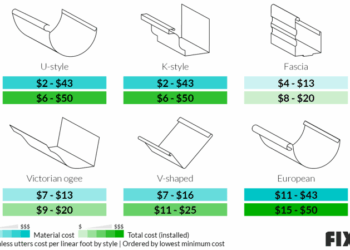In the realm of interior design, the emergence of AI-powered platforms has revolutionized the way spaces are conceptualized and created. This captivating development blends cutting-edge technology with artistic flair, offering users a glimpse into a future where design possibilities are limitless.
As we delve deeper into the intricacies of AI-powered interior design platforms, a world of innovation and creativity unfolds before us.
Introduction to AI-Powered Interior Design Platforms
AI-powered interior design platforms utilize artificial intelligence algorithms to assist homeowners, interior designers, and decorators in creating aesthetically pleasing and functional spaces. These platforms leverage AI technology to streamline the design process, enhance creativity, and provide personalized recommendations based on user preferences.
How AI is Transforming the Interior Design Industry
AI is revolutionizing the interior design industry by offering innovative solutions that were previously time-consuming or inaccessible. With AI-powered platforms, designers can efficiently generate 3D models, experiment with different layouts, and visualize the final result before implementation. This technology enables faster decision-making, reduces costs, and improves overall design quality.
The Benefits of Using AI in Interior Design
- Personalization: AI algorithms can analyze user data and preferences to offer tailored design suggestions.
- Efficiency: AI-powered platforms automate repetitive tasks, saving time and allowing designers to focus on creativity.
- Cost-Effectiveness: By optimizing design processes, AI helps reduce expenses associated with manual labor and revisions.
- Trend Analysis: AI can track design trends and provide insights to help designers stay current and competitive in the market.
- Enhanced Visualization: AI technology enables realistic 3D renderings and virtual walkthroughs, allowing clients to visualize the final design more effectively.
Technology Behind AI-Powered Interior Design Platforms
AI-powered interior design platforms leverage a combination of cutting-edge technologies to revolutionize the way interior design is approached. These platforms utilize machine learning algorithms to analyze data and provide personalized design solutions tailored to the user's preferences and requirements.
Machine Learning Integration
Machine learning plays a crucial role in AI-powered interior design platforms by enabling the systems to learn from user interactions, preferences, and feedback. Through the use of machine learning algorithms, these platforms can continuously improve their design recommendations based on patterns and trends identified in the data.
Role of Algorithms in Personalized Design Solutions
Algorithms are at the core of creating personalized design solutions in AI-powered interior design platforms. These algorithms analyze various data points such as user input, design styles, color preferences, and room layouts to generate customized design recommendations. By processing this data, the algorithms can offer tailored design suggestions that align with the user's unique tastes and requirements.
Features and Functionalities of AI-Powered Interior Design Platforms
AI-powered interior design platforms offer a variety of features and functionalities to assist users in visualizing design concepts and enhancing customization and personalization of interior design solutions.
Key Features Available on AI-Powered Interior Design Platforms
- Virtual Room Visualization: Users can upload a photo of their room and experiment with different furniture layouts, colors, and decor virtually.
- Style Recommendations: AI algorithms analyze user preferences and offer personalized style recommendations for furniture and decor based on their tastes.
- Product Sourcing: These platforms provide links to purchase furniture and decor items directly from retailers, making it easy for users to buy the products they like.
- Room Measurement Tools: AI-powered tools help users measure their room dimensions accurately to ensure furniture and decor items fit perfectly.
- Customization Options: Users can customize furniture pieces, fabrics, colors, and finishes to create unique and personalized designs.
How AI-Powered Interior Design Platforms Assist Users in Visualizing Design Concepts
AI-powered interior design platforms use advanced algorithms to generate realistic 3D renderings of design concepts, allowing users to see how different furniture and decor items will look in their space before making any purchases. This visualization helps users make informed decisions and visualize their design ideas more effectively.
How AI Enhances the Customization and Personalization of Interior Design Solutions
AI algorithms analyze user preferences, browsing history, and interactions with the platform to offer personalized recommendations and suggestions for interior design solutions. By understanding user preferences and style choices, AI helps users create customized and personalized designs that reflect their unique tastes and preferences.
User Experience with AI-Powered Interior Design Platforms
When it comes to user experience with AI-powered interior design platforms, feedback has been largely positive. Users appreciate the convenience, time-saving features, and personalized recommendations that these platforms offer.
Influence of AI Recommendations on User Decisions
AI recommendations play a significant role in influencing user decisions when it comes to design choices. By analyzing user preferences, style trends, and space constraints, AI algorithms can suggest color schemes, furniture layouts, and decor items that align with the user's taste and requirements.
Usability and Accessibility for Professionals and Homeowners
- Professionals: Interior designers and decorators find AI-powered platforms to be valuable tools that streamline their workflow, enhance creativity, and improve client collaboration. The ability to generate 3D renderings, mood boards, and material lists quickly saves time and allows professionals to focus on the creative aspects of their work.
- Homeowners: For homeowners, AI-powered interior design platforms offer a user-friendly interface that simplifies the design process. From visualizing different layout options to virtually trying out furniture placements, these platforms empower homeowners to make informed design decisions without the need for professional assistance.
Comparison with Traditional Interior Design Methods
AI-powered interior design platforms have revolutionized the way interior design is approached, offering a more efficient and cost-effective alternative to traditional methods. Let's delve into the comparison between AI-powered platforms and traditional interior design practices.
Efficiency and Time-saving
AI-powered interior design platforms significantly enhance efficiency by streamlining the design process. These platforms utilize algorithms and data analysis to quickly generate design recommendations based on user preferences. In contrast, traditional interior design methods often involve multiple consultations, revisions, and manual work, which can be time-consuming.
Cost-effectiveness
AI-powered interior design platforms are a cost-effective solution for those looking to redesign their spaces without breaking the bank. These platforms typically offer affordable subscription plans or pay-per-use options, making them accessible to a wider audience. On the other hand, traditional interior design services can be expensive, involving hefty consultation fees and markups on furniture and decor.
Limitations of AI-powered Platforms
While AI-powered interior design platforms offer efficiency and cost-effectiveness, they have limitations compared to human designers. AI may struggle with complex design challenges that require a nuanced understanding of aesthetics and spatial dynamics. Additionally, AI may lack the personal touch and creativity that human designers bring to the table, making it challenging to fully replace the human element in interior design.
Future Trends in AI-Powered Interior Design Platforms
AI technology is constantly evolving, and its impact on interior design is expected to grow significantly in the coming years. With advancements in AI algorithms and the integration of virtual reality (VR) and augmented reality (AR), the future of AI-powered interior design platforms looks promising.
Potential Advancements in AI Algorithms
AI algorithms used in interior design platforms are likely to become more sophisticated, enabling them to analyze user preferences, styles, and trends with greater accuracy. These advancements will result in more personalized and tailored design solutions for users.
Integration of Virtual Reality and Augmented Reality
The integration of VR and AR technologies in AI-powered interior design platforms will revolutionize the way users experience designs. With VR, users can immerse themselves in virtual spaces and visualize how different elements will look in their real environment. AR, on the other hand, allows users to overlay digital designs onto their physical surroundings, giving them a realistic preview of the final look.
Summary
As we conclude our exploration of AI-powered interior design platforms, one thing is clear - the future of design is intertwined with the evolution of AI technology. With limitless potential and boundless creativity, these platforms are set to redefine the very essence of interior design.
Popular Questions
How do AI-powered interior design platforms impact the traditional design process?
AI-powered platforms streamline the design process, offering quicker solutions and personalized recommendations based on user preferences.
Are AI-powered interior design platforms accessible to individuals with no design background?
Yes, these platforms are designed to be user-friendly and intuitive, making them accessible to anyone looking to explore design possibilities.
Can AI accurately predict design trends in the interior design industry?
AI algorithms can analyze patterns and data to make informed predictions about upcoming design trends, offering valuable insights to designers and users alike.
In the realm of interior design, the emergence of AI-powered platforms has revolutionized the way spaces are conceptualized and created. This captivating development blends cutting-edge technology with artistic flair, offering users a glimpse into a future where design possibilities are limitless.
As we delve deeper into the intricacies of AI-powered interior design platforms, a world of innovation and creativity unfolds before us.
Introduction to AI-Powered Interior Design Platforms
AI-powered interior design platforms utilize artificial intelligence algorithms to assist homeowners, interior designers, and decorators in creating aesthetically pleasing and functional spaces. These platforms leverage AI technology to streamline the design process, enhance creativity, and provide personalized recommendations based on user preferences.
How AI is Transforming the Interior Design Industry
AI is revolutionizing the interior design industry by offering innovative solutions that were previously time-consuming or inaccessible. With AI-powered platforms, designers can efficiently generate 3D models, experiment with different layouts, and visualize the final result before implementation. This technology enables faster decision-making, reduces costs, and improves overall design quality.
The Benefits of Using AI in Interior Design
- Personalization: AI algorithms can analyze user data and preferences to offer tailored design suggestions.
- Efficiency: AI-powered platforms automate repetitive tasks, saving time and allowing designers to focus on creativity.
- Cost-Effectiveness: By optimizing design processes, AI helps reduce expenses associated with manual labor and revisions.
- Trend Analysis: AI can track design trends and provide insights to help designers stay current and competitive in the market.
- Enhanced Visualization: AI technology enables realistic 3D renderings and virtual walkthroughs, allowing clients to visualize the final design more effectively.
Technology Behind AI-Powered Interior Design Platforms
AI-powered interior design platforms leverage a combination of cutting-edge technologies to revolutionize the way interior design is approached. These platforms utilize machine learning algorithms to analyze data and provide personalized design solutions tailored to the user's preferences and requirements.
Machine Learning Integration
Machine learning plays a crucial role in AI-powered interior design platforms by enabling the systems to learn from user interactions, preferences, and feedback. Through the use of machine learning algorithms, these platforms can continuously improve their design recommendations based on patterns and trends identified in the data.
Role of Algorithms in Personalized Design Solutions
Algorithms are at the core of creating personalized design solutions in AI-powered interior design platforms. These algorithms analyze various data points such as user input, design styles, color preferences, and room layouts to generate customized design recommendations. By processing this data, the algorithms can offer tailored design suggestions that align with the user's unique tastes and requirements.
Features and Functionalities of AI-Powered Interior Design Platforms
AI-powered interior design platforms offer a variety of features and functionalities to assist users in visualizing design concepts and enhancing customization and personalization of interior design solutions.
Key Features Available on AI-Powered Interior Design Platforms
- Virtual Room Visualization: Users can upload a photo of their room and experiment with different furniture layouts, colors, and decor virtually.
- Style Recommendations: AI algorithms analyze user preferences and offer personalized style recommendations for furniture and decor based on their tastes.
- Product Sourcing: These platforms provide links to purchase furniture and decor items directly from retailers, making it easy for users to buy the products they like.
- Room Measurement Tools: AI-powered tools help users measure their room dimensions accurately to ensure furniture and decor items fit perfectly.
- Customization Options: Users can customize furniture pieces, fabrics, colors, and finishes to create unique and personalized designs.
How AI-Powered Interior Design Platforms Assist Users in Visualizing Design Concepts
AI-powered interior design platforms use advanced algorithms to generate realistic 3D renderings of design concepts, allowing users to see how different furniture and decor items will look in their space before making any purchases. This visualization helps users make informed decisions and visualize their design ideas more effectively.
How AI Enhances the Customization and Personalization of Interior Design Solutions
AI algorithms analyze user preferences, browsing history, and interactions with the platform to offer personalized recommendations and suggestions for interior design solutions. By understanding user preferences and style choices, AI helps users create customized and personalized designs that reflect their unique tastes and preferences.
User Experience with AI-Powered Interior Design Platforms
When it comes to user experience with AI-powered interior design platforms, feedback has been largely positive. Users appreciate the convenience, time-saving features, and personalized recommendations that these platforms offer.
Influence of AI Recommendations on User Decisions
AI recommendations play a significant role in influencing user decisions when it comes to design choices. By analyzing user preferences, style trends, and space constraints, AI algorithms can suggest color schemes, furniture layouts, and decor items that align with the user's taste and requirements.
Usability and Accessibility for Professionals and Homeowners
- Professionals: Interior designers and decorators find AI-powered platforms to be valuable tools that streamline their workflow, enhance creativity, and improve client collaboration. The ability to generate 3D renderings, mood boards, and material lists quickly saves time and allows professionals to focus on the creative aspects of their work.
- Homeowners: For homeowners, AI-powered interior design platforms offer a user-friendly interface that simplifies the design process. From visualizing different layout options to virtually trying out furniture placements, these platforms empower homeowners to make informed design decisions without the need for professional assistance.
Comparison with Traditional Interior Design Methods
AI-powered interior design platforms have revolutionized the way interior design is approached, offering a more efficient and cost-effective alternative to traditional methods. Let's delve into the comparison between AI-powered platforms and traditional interior design practices.
Efficiency and Time-saving
AI-powered interior design platforms significantly enhance efficiency by streamlining the design process. These platforms utilize algorithms and data analysis to quickly generate design recommendations based on user preferences. In contrast, traditional interior design methods often involve multiple consultations, revisions, and manual work, which can be time-consuming.
Cost-effectiveness
AI-powered interior design platforms are a cost-effective solution for those looking to redesign their spaces without breaking the bank. These platforms typically offer affordable subscription plans or pay-per-use options, making them accessible to a wider audience. On the other hand, traditional interior design services can be expensive, involving hefty consultation fees and markups on furniture and decor.
Limitations of AI-powered Platforms
While AI-powered interior design platforms offer efficiency and cost-effectiveness, they have limitations compared to human designers. AI may struggle with complex design challenges that require a nuanced understanding of aesthetics and spatial dynamics. Additionally, AI may lack the personal touch and creativity that human designers bring to the table, making it challenging to fully replace the human element in interior design.
Future Trends in AI-Powered Interior Design Platforms
AI technology is constantly evolving, and its impact on interior design is expected to grow significantly in the coming years. With advancements in AI algorithms and the integration of virtual reality (VR) and augmented reality (AR), the future of AI-powered interior design platforms looks promising.
Potential Advancements in AI Algorithms
AI algorithms used in interior design platforms are likely to become more sophisticated, enabling them to analyze user preferences, styles, and trends with greater accuracy. These advancements will result in more personalized and tailored design solutions for users.
Integration of Virtual Reality and Augmented Reality
The integration of VR and AR technologies in AI-powered interior design platforms will revolutionize the way users experience designs. With VR, users can immerse themselves in virtual spaces and visualize how different elements will look in their real environment. AR, on the other hand, allows users to overlay digital designs onto their physical surroundings, giving them a realistic preview of the final look.
Summary
As we conclude our exploration of AI-powered interior design platforms, one thing is clear - the future of design is intertwined with the evolution of AI technology. With limitless potential and boundless creativity, these platforms are set to redefine the very essence of interior design.
Popular Questions
How do AI-powered interior design platforms impact the traditional design process?
AI-powered platforms streamline the design process, offering quicker solutions and personalized recommendations based on user preferences.
Are AI-powered interior design platforms accessible to individuals with no design background?
Yes, these platforms are designed to be user-friendly and intuitive, making them accessible to anyone looking to explore design possibilities.
Can AI accurately predict design trends in the interior design industry?
AI algorithms can analyze patterns and data to make informed predictions about upcoming design trends, offering valuable insights to designers and users alike.










